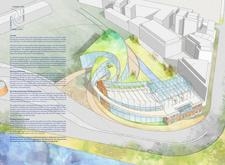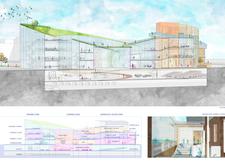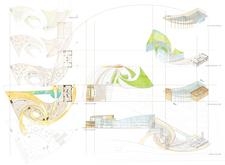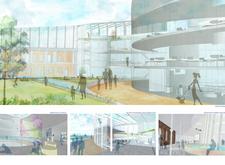5 key facts about this project
At the core of the project is the idea of connectivity, both physically and visually. The architecture promotes interaction among users and the surrounding environment. Key design elements include open spaces that encourage social gatherings, strategically placed windows that frame views of the surrounding landscape, and pathways that guide visitors through the site. This facilitates an exploratory experience, allowing users to engage with the building in a dynamic way.
The function of the project is multifaceted, serving as a community hub that accommodates a variety of activities. These include exhibition spaces, meeting rooms, and recreational areas, all designed to foster collaborations and exchanges. The architectural layout supports this diverse use by providing flexible spaces that can adapt to different needs, reinforced by a strong integration of indoor and outdoor environments. This blurring of boundaries enhances the overall user experience, allowing nature to become an integral aspect of the architecture.
Materiality plays a significant role in the project’s identity. A combination of natural and sustainable materials has been selected to create a sense of warmth and approachability. The use of locally sourced timber not only reflects the regional character but also contributes to sustainability goals by minimizing transportation costs and environmental impact. Additionally, recycled metal elements are incorporated into the design, providing structural support while symbolizing a commitment to innovative and responsible building practices. Large areas of glazing are utilized to maximize natural light, creating an inviting atmosphere while reducing energy consumption.
Unique design approaches are evident throughout the architecture, particularly in the way the project responds to its surroundings. The layout respects existing topography and vegetation, enhancing the natural beauty of the site. Green roofs are a prominent feature, promoting biodiversity and aiding in stormwater management, further emphasizing the project’s sustainability mindset. The careful selection of plantings around the building enhances both privacy and aesthetics, creating a resilient landscape that engages with local ecosystems.
The architectural plans showcase a meticulous attention to detail in organizing spaces for optimal utility and flow. The integration of sustainable design principles such as passive heating and cooling strategies and efficient water usage reflects an awareness of contemporary environmental challenges. Architectural sections reveal the thoughtful layering of spaces, providing insights into how the structure interacts with daylight and seasonal changes.
Overall, this architectural project exemplifies a harmonious blend of innovation and respect for context, prioritizing both community needs and environmental stewardship. The design promotes interaction and connectivity in an inviting environment, successfully fostering a sense of belonging among users. As such, it stands as a notable reference point for modern architectural practices aspiring to balance functionality with sustainability.
For those interested in a deeper exploration of the architectural ideas presented, reviewing the architectural plans, sections, and detailed designs will offer valuable insights into the project’s conceptual underpinnings and practical applications. This further investigation illustrates the careful thought and creativity that underpin the design, inviting a broader conversation on architecture's role in community enhancement and ecological responsibility.


























